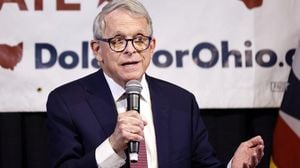With the 2024 U.S. presidential election swiftly approaching, tension hung heavy over the nation. The race, seen as the rematch of former President Donald Trump and current Vice President Kamala Harris, was intensifying as Election Day neared. Initial projections suggested it would be as tight as it could get, with numerous key swing states playing pivotal roles. The stakes couldn't have been higher, with both candidates prepared to declare victory even before the results were finalized.
After polls closed on November 5, 2024, Trump was among the first to seize the narrative, making headlines by confidently declaring victory the next day. With the Associated Press reporting him on the brink of securing the 270 electoral votes necessary for victory, he rallied supporters with the announcement, "We have done it!" This declaration set the media abuzz with analysis and speculation about what the future might behold.
While Trump seemed to be fairly coasting his way toward the numbers he needed, Harris was not without her wins. She secured Minnesota early on, along with states like New Hampshire and Oregon, demonstrating the far-from-lopsided nature of the contest. Her home state of California, carrying the largest number of electoral votes, was also announced as safely under her control, albeit still trailing with Trump sitting solidly at 230 electoral votes to Harris’s 209 at times throughout the evening.
The election showcased stark divisions, particularly around pivotal swing states like Georgia, North Carolina, and Pennsylvania. Trump’s win of Pennsylvania proved monumental, with the state traditionally leaning blue but flipping to support him reminiscently from his 2016 campaign. This victory gave him substantial momentum, as Pennsylvania has been known to swing elections heavily due to the sheer number of electoral votes it carries. With Pennsylvania’s call, Trump's tally surged as he garnered states like Georgia and North Carolina, securing up to three swing states by the early hours of Wednesday morning.
Harris's campaign, on the other hand, remained steadfast, claiming victories across Democratic strongholds and targeting pockets of support where independent voters seemed to be shifting. Throughout the evening, Harris’s running mate, Governor Tim Walz of Minnesota, highlighted Harris’s appeal, noting their commitment to fighting for the issues central to the Democratic agenda. Harris was seen as skillfully engaging voters over issues of significance, including rising costs of living and access to healthcare.
While the race was fluid, polling data shed light on the larger concerns of the electorate. Initial exit polling indicated many voters were dissatisfied with the current state of affairs. Roughly 72% felt negatively about the direction the country was heading, expressing fears around economic stability and the effectiveness of political leadership. Voter sentiment on both sides suggested concerns about divided governance and partisan squabbling.”
Trump's victory declarations were met with skepticism from some media outlets. The Associated Press, among others, remained cautious, waiting for definitive numbers from several undecided states before calling the necessary victory for Trump. Instead, they reported victories as results steadily rolled in, creating what some might call election control amid contested results.
It was evident on the night of Election Day how the emotional spectrum of voters was heavily influenced by issues. Analysis revealed abortion and immigration were not as prominent among voting concerns as economic policies and perceptions of government efficacy, which saw around 31% of voters placing their trust primarily on the economy. An early glimpse at the data suggested voters were less energized by social issues particularly after the heightened discourse surrounding them leading up to the elections.
Particularly intriguing were the reactions of some Republican officials during the election, including Governor Phil Scott of Vermont, who publicly stated he had cast his vote for Harris instead of Trump. Scott’s breakaway from party lines reflected how some moderates were grappling with discontent surrounding Trump's divisive style, illustrating the unique fractures present within the Republican voter bloc.
Meanwhile, financial markets stirred with Trump’s lead, as stock indices responded almost immediately to his prospective victory by rallying significantly. The small-cap Russell 2000 index saw gains approaching 6%, as investors reacted positively to anticipated Republican policies potentially leading to economic boosts. The U.S. dollar surged against foreign currencies, foreshadowing changes to trade dynamics internationally.
Gold, traditionally viewed as a hedge against political instability, faced volatility, following initial plunges immediately after Election Day. Traders were wary, as earlier selling trends mirrored those seen following Trump’s historic victory over Hillary Clinton eight years prior. Many investors began to speculate on whether gold would once again suffer losses under the pressure of perceived stability shifting back toward Republican governance.
Despite electoral wins, the split decision from various states continued to keep the nation on edge. Key battlegrounds such as Arizona, Michigan, Wisconsin, and Nevada remained under scrutiny as they awaited definitive outcomes. Each swing state had the potential to tip the scales, leading many to keep their eyes glued to the polling stations as results trickled through the night. The tension surrounding these elections was palpable, with voters on both sides eager to see how their aspirations would translate to the ballot box.
With fishing out consequences came the immediate fallout of community sentiment, leading both candidates to reflect on their projected performance moving forward. Trump's campaign team, buoyed by early victories, began crafting strategies aimed at retaining the support of his base, focusing on sociocultural narratives underscored by his previous administration’s policies. Conversely, Harris's camp cried foul over media narratives being spun prior to results being officially solidified and shifted their messaging to discourage complacency.
Creating avenues for outreach among independents had been instrumental for both campaigns, and each candidate appeared focused on solidifying connections with their respective bases of voters. Harris championed inclusivity, emphasizing her intentions to promote equity and civil rights, promoting grassroots programs to sway swing voters, particularly those disenchanted with current economic conditions. Trump's narrative remained entrenched around perceived strength and stances on law and order, framing his electoral challenge as fight against perceived radicalism.
The long shadow of partisanship loomed heavily over the results as America would not only be left to reflect on the outcome of this election but also on the ramifications of polarized ideologies filling the political sphere. Observers tracking voter turnout noted fluctuatings trends among different demographic groups—a swell of suburban voters, women, and independents impacting the outcomes.
Going forward, scrutiny surrounding legislative progress promised to become contentious once more within Congress as strategists predicted heated confrontations scripted with the backdrop of newly drawn battle lines. The current election had transcended inclinations of party loyalty, making apparent shifts among undecided voters these past months would introduce challenges for policymakers aiming to enact significant categorizations across party lines.
Only time would tell how this election’s dynamics would continue shaping American governance—but as results continued to embody shifts, expectations loomed on whether 2024 would guide voters back to bipartisanship or solidify their leanings toward more radical ends of the spectrum. With the stakes firmly aligned on both sides, the contest continued, and the nation held its breath waiting for clarity amid uncertainty. Will 2024 be remembered as the turning point toward increasing unity or the start of widening schisms? The future remained uncertain, but the election had ushered the conversation to new heights, and battle lines had long been drawn.



